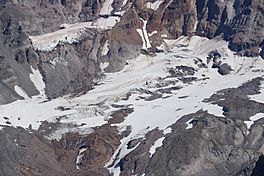Sandy Glacier facts for kids
Quick facts for kids Sandy Glacier |
|
|---|---|
 |
|
| Type | Mountain glacier |
| Location | Clackamas County, Oregon, United States |
| Coordinates | 45°22′51″N 121°43′08″W / 45.38083°N 121.71889°W |
| Area | 237 acres (96 ha) (2004 estimate) |
| Terminus | Ice fall |
| Status | Retreating |
Sandy Glacier is a large river of ice found on the side of Mount Hood in Oregon, USA. It stretches from high up on the mountain down to lower areas. This glacier is the starting point for a stream called Muddy Fork, which then flows into the Sandy River.
Contents
Sandy Glacier: A Giant Ice River
Sandy Glacier is a type of alpine glacier. This means it's a glacier that forms in mountains. It sits on the western side of Mount Hood. The glacier goes from about 8,800 feet (2,682 meters) high down to about 6,000 feet (1,829 meters).
High up on the glacier, you can find many deep cracks called crevasses. These cracks form when the ice moves and stretches. Sandy Glacier is a leftover piece from the huge glaciers that covered the land during the last ice age.
Where is Sandy Glacier?
This glacier is located entirely within the Mount Hood Wilderness. It is found in Clackamas County, Oregon. To its south is a ridge called Yocum Ridge. This ridge also marks the northern edge of another glacier, Reid Glacier. To the north, another ridge separates Sandy Glacier from Glisan Glacier.
The Amazing Sandy Glacier Caves
The lower part of Sandy Glacier was once home to the Sandy Glacier Caves. These were amazing ice caves, possibly the biggest glacier cave system in the lower 48 U.S. states. Glacier caves are tunnels and rooms that form inside a glacier. They are created when water melts and flows through the ice. Sadly, these caves have mostly melted away due to changes in the glacier.
How Sandy Glacier is Changing
Like many glaciers around the world, Sandy Glacier is getting smaller. Between 1907 and 2004, the glacier's total area shrank by 40%. The end of the glacier, called the glacier terminus, has also moved back. It has retreated by about 690 meters (2,264 feet) during the same time period. This means the glacier is shrinking and pulling back up the mountain.
Why Glaciers Change
Glaciers like Sandy Glacier are very sensitive to changes in temperature. When the climate gets warmer, more ice melts than can be replaced by new snowfall. This causes glaciers to shrink and retreat. Scientists study glaciers to understand how our planet's climate is changing.


